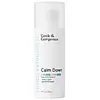What's inside
What's inside
 Key Ingredients
Key Ingredients

 Benefits
Benefits

 Concerns
Concerns

No concerns
 Ingredients Side-by-side
Ingredients Side-by-side

Water
Skin ConditioningCellulose
AbsorbentPentylene Glycol
Skin ConditioningCoco-Caprylate/Caprate
EmollientGlycerin
HumectantAmmonium Acryloyldimethyltaurate/Vp Copolymer
Chrysanthemum Sinense Flower Extract
CleansingCeramide NP
Skin ConditioningSodium Hyaluronate
HumectantDipotassium Glycyrrhizate
HumectantLactobionic Acid
BufferingAllantoin
Skin ConditioningPropanediol
SolventCaprylic/Capric Triglyceride
MaskingHydrogenated Lecithin
EmulsifyingPhytosteryl/Octyldodecyl Lauroyl Glutamate
Skin ConditioningSodium Gluconate
Skin ConditioningEthylhexylglycerin
Skin ConditioningWater, Cellulose, Pentylene Glycol, Coco-Caprylate/Caprate, Glycerin, Ammonium Acryloyldimethyltaurate/Vp Copolymer, Chrysanthemum Sinense Flower Extract, Ceramide NP, Sodium Hyaluronate, Dipotassium Glycyrrhizate, Lactobionic Acid, Allantoin, Propanediol, Caprylic/Capric Triglyceride, Hydrogenated Lecithin, Phytosteryl/Octyldodecyl Lauroyl Glutamate, Sodium Gluconate, Ethylhexylglycerin
Water
Skin ConditioningGlycereth-26
HumectantGluconolactone
Skin ConditioningLactobionic Acid
BufferingPropanediol
SolventSalicylic Acid
MaskingPanthenol
Skin ConditioningGlycerin
HumectantOpuntia Ficus-Indica Extract
Skin ConditioningSaccharomyces Cerevisiae Extract
Skin ConditioningPhragmites Karka Extract
Skin ConditioningPoria Cocos Extract
Skin ConditioningSodium Hydroxide
BufferingPhenoxyethanol
Preservative
 Reviews
Reviews

Ingredients Explained
These ingredients are found in both products.
Ingredients higher up in an ingredient list are typically present in a larger amount.
Glycerin is already naturally found in your skin. It helps moisturize and protect your skin.
A study from 2016 found glycerin to be more effective as a humectant than AHAs and hyaluronic acid.
As a humectant, it helps the skin stay hydrated by pulling moisture to your skin. The low molecular weight of glycerin allows it to pull moisture into the deeper layers of your skin.
Hydrated skin improves your skin barrier; Your skin barrier helps protect against irritants and bacteria.
Glycerin has also been found to have antimicrobial and antiviral properties. Due to these properties, glycerin is often used in wound and burn treatments.
In cosmetics, glycerin is usually derived from plants such as soybean or palm. However, it can also be sourced from animals, such as tallow or animal fat.
This ingredient is organic, colorless, odorless, and non-toxic.
Glycerin is the name for this ingredient in American English. British English uses Glycerol/Glycerine.
Learn more about GlycerinLactobionic Acid is a PHA. PHAs are the gentle cousins to AHAS.
Like AHAs, they exfoliate the top layer of skin. Lactobionic acid also exhibits significant antioxidant activity.
PHAs are more gentle than AHAs due to their larger structure. This means they do not penetrate as deeply as AHAs and take a longer time to dissolve dead cells. Studies show PHAs do not cause as much irritation.
By removing dead skin cells, PHAs leave the skin brighter and with even-texture.
Learn more about Lactobionic AcidPropanediol is an all-star ingredient. It softens, hydrates, and smooths the skin.
It’s often used to:
Propanediol is not likely to cause sensitivity and considered safe to use. It is derived from corn or petroleum with a clear color and no scent.
Learn more about PropanediolWater. It's the most common cosmetic ingredient of all. You'll usually see it at the top of ingredient lists, meaning that it makes up the largest part of the product.
So why is it so popular? Water most often acts as a solvent - this means that it helps dissolve other ingredients into the formulation.
You'll also recognize water as that liquid we all need to stay alive. If you see this, drink a glass of water. Stay hydrated!
Learn more about Water